|
|
ARTHROPODS:
Insects»
Spiders»
Centipedes»
Millipedes»
Sowbugs»
Harvestmen»
Mites
& Ticks»
Scorpions»
Identification
Tips»
About
the Critter Files»
Links» |
|
|
|
| |
| TAXONOMY |
KINGDOM: Animalia
| PHYLUM: Arthropoda | CLASS: Insecta | ORDER:Coleoptera | FAMILY:Lucanidae
(stag beetles) |
| |
| Other
Names: Lucanids, pinching bugs |
| |
WHAT
IS A STAG BEETLE?
LIFE CYCLE
ECOLOGY
PEST STATUS
COMMON KENTUCKY STAG BEETLES
COLLECTING & PHOTOGRAPHY
STAG BEETLE FACTS
MYTHS, LEGENDS, AND FOLKLORE |
| |
| WHAT
IS A STAG BEETLE? |
|
Like
all beetles, Stag Beetles have chewing mouthparts
and hardened front wings (elytra) that meet in a straight line
down the back of the abdomen when closed. Stag beetles
range from reddish brown to black and have long legs with spiny
tibia that are wide at the tips (pictured below left). The antennae
are often elbowed with a comb-like club on the end (below right).
Stag beetles are similar in appearance to the closely
related Bess Beetles (Passalidae), but bess beetles do not have
elbowed antennae and stag beetles do not have a horn like bess
beetles have. There are 30 different species of stag beetles
in the US. Two-thirds of them live in the western half
of the country, but Kentucky is home to several species. |
| |
|
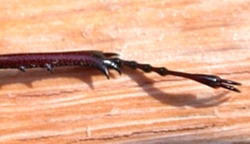 Stag Beetle Tibia (B. Newton, 2005)
Stag Beetle Tibia (B. Newton, 2005) |
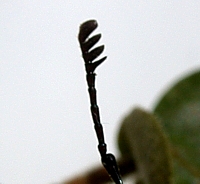 Stag
Beetle Antenna (B. Newton, 2005)
Stag
Beetle Antenna (B. Newton, 2005) |
|
| |
| SIZE:Adult body length up to 60mm, most species
between 15-35mm. |
| |
| LIFE
CYCLE |
|
Like all beetles, stag beetles have "complete" metamorphosis
with egg, larval, pupal, and adult stages. In many stag
beetle species, females lay their eggs on or under the bark
of dead, fallen trees. Upon hatching, larvae chew their
way into the tree and feed on the juices of the decaying wood.
Once they complete development (a process which may take
several years), the larvae pupate in small chambers in the soil
near their food source. When the adult emerges it searches
for a mate. The males in some species use their huge jaws
to fight each other over females. Adults live for 1-2
years, depending on the species. |
| |
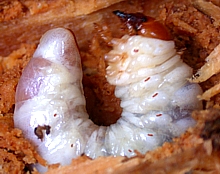 Stag Beetle Larva (B. Newton, 2005)
Stag Beetle Larva (B. Newton, 2005) |
| |
| ECOLOGY |
|
| Stag beetles are slow-moving herbivores that climb well and are believed
to feed on leaves, sap, and aphid honeydew. Kentucky species
are found in wooded areas, but there are a few species from other
parts of the world that live on beaches. Not much is known
about the feeding habits of adult stag beetles, but they are often
seen flying to lights at night during the summer. When disturbed,
a stag beetle will rear back and hold its head high with its mandibles
open. |
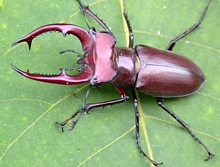 Male
Elephant Stag Beetle (B. Newton, 2004)
Male
Elephant Stag Beetle (B. Newton, 2004) |
| |
Because they help with
the decomposition of dead trees, stag beetle larvae (like termites
and other creatures) are a vital part of the forest ecosystem. No
healthy hardwood forest in Kentucky is without stag beetle larvae.
Stag beetles and their
larvae are food for a variety of animals, including birds, lizards,
snakes, toads, raccoons, centipedes, and mustellids (weasels, skunks,
etc.).
|
| |
| PEST
STATUS |
|
Stag beetles are
not considered pests. They are beneficial insects because
they help with the decomposition process of dead wood in forests. |
| |
| COMMON
KENTUCKY STAG BEETLES |
|
|
COMMON STAG BEETLE
GENUS:
Psuedolucanus
Common Stag
Beetles, also called "Pinching Bugs," are the
2nd largest of the stag beetles, after the Elephant
Stags. There are four species of pinching bugs in the genus Psuedolucanus, and all are similar in size and appearance.
Females of both the common and elephant stag beetles look
almost identical, but males can be distinguished by the mandibles,
which are considerably smaller in the male common stag beetle.
Common stag beetles are reddish brown and grow to be 22-40mm
in length. Like most other stag beetles, these beetles eat
decaying wood as larvae; the adults eat little or nothing. |
| |
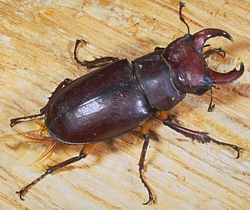 Common Stag Beetle, male (R. Bessin, 2000)
Common Stag Beetle, male (R. Bessin, 2000) |
|
|
|
ELEPHANT STAG BEETLE
GENUS:Lucanus
Elephant Stag Beetles,
also called "Giant Stag Beetles," are among the largest
beetles found in Kentucky, growing to lengths of 60mm. Elephant
stag beetles and their larvae are common in forested areas where
decaying wood is present. Larvae are about the same length
as the adults. Adult males have heads with huge, branching
mandibles that are more than half as long as the beetle itself. |
| |
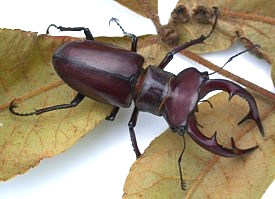 Elephant Stag Beetle, male (L. Thomas, 2005)
Elephant Stag Beetle, male (L. Thomas, 2005) |
|
|
|
Ceruchus piceus
GENUS:Ceruchus
Ceruchus piceus is one of several stag beetle species that are much smaller (8-15 mm) than the beetles pictured above. These small stag beetles can easily be mistaken for
beetles in other families (such as ground
beetles), but can be distinguished by their elbowed antennae. Thanks to Ken Fujita from Saint Louis University for helping us to identify this stag beetle. |
| |
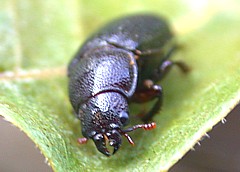 Ceruchus piceus female (B. Newton, 2005)
Ceruchus piceus female (B. Newton, 2005) |
|
| |
| COLLECTING
& PHOTOGRAPHY |
|
Look for stag
beetles and their larvae in rotting logs and under loose bark.
In Kentucky, these beetles are common in healthy woodlands
with lots of fallen hardwood trees. Almost all species
will crawl or fly to lights at night. Contrary to their
threatening appearance, stag beetles can be handled with little
fear of injury, since they can do little more than give a mild
pinch. It
is relatively easy to get pictures of the larger stag beetles
since they are very slow moving, though for the smaller ones
it can be more difficult. Often, the best plan is to capture
one, place it in a regular refrigerator for about 10 minutes,
and then take its picture while it is warming up (this will
not harm the beetle). During this period, the beetle will
move slowly (it will recover quickly though, so you have to
be fast with your camera!).
|
| |
| STAG
BEETLE FACTS |
|
Stag beetles are named
because of the large branching mandibles, similar to those of
the mammalian stags. Also like stags and similar mammals
(deer, rams), male stag beetles use these "antlers"
to fight with one another for mating privileges.
In Britain, stag
beetles were once very common, but are now threatened because
of cleared forests and the lack of large fallen hardwood trees.
In Japan, rearing
stag beetles is a popular hobby. Take a look at this on-line
guide to stag beetle husbandry:
http://www1.kamakuranet.ne.jp/kabu/beet/x-manual-siiku2.htm |
| |
| MYTHS
- LEGENDS - FOLKLORE |
|
Have you heard any
myths, legends, or folklore about stag beetles? If so, let
us know. |
| |
Original document: 9 June 2005
Last updated: 23 June 2017
Photos courtesy L. Thomas,
R. Bessin, and B. Newton, University of Kentucky
The Kentucky Critter
Files are maintained by Blake Newton, Department of Entomology, University
of Kentucky.
Contact: blaken@uky.edu |
|

